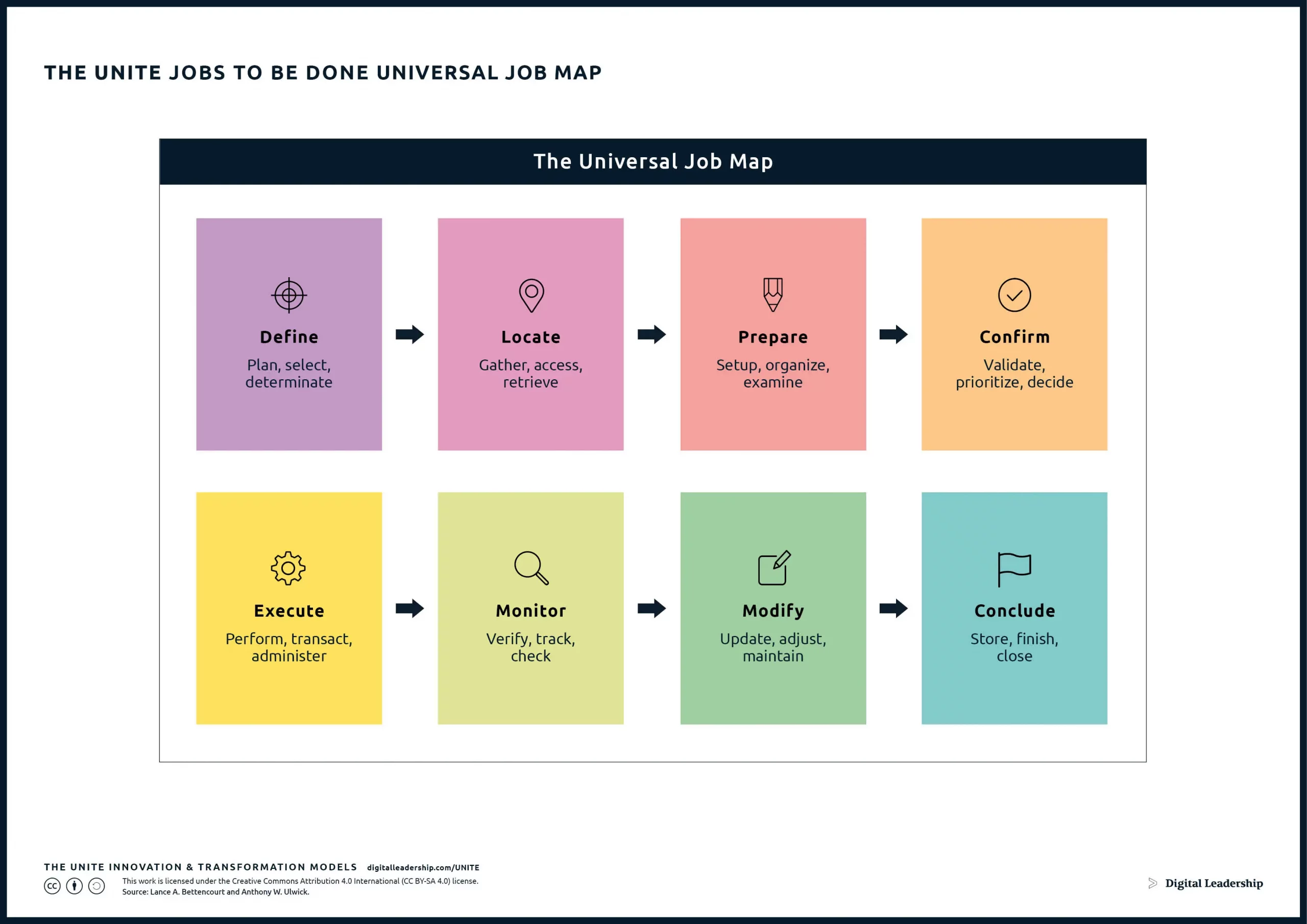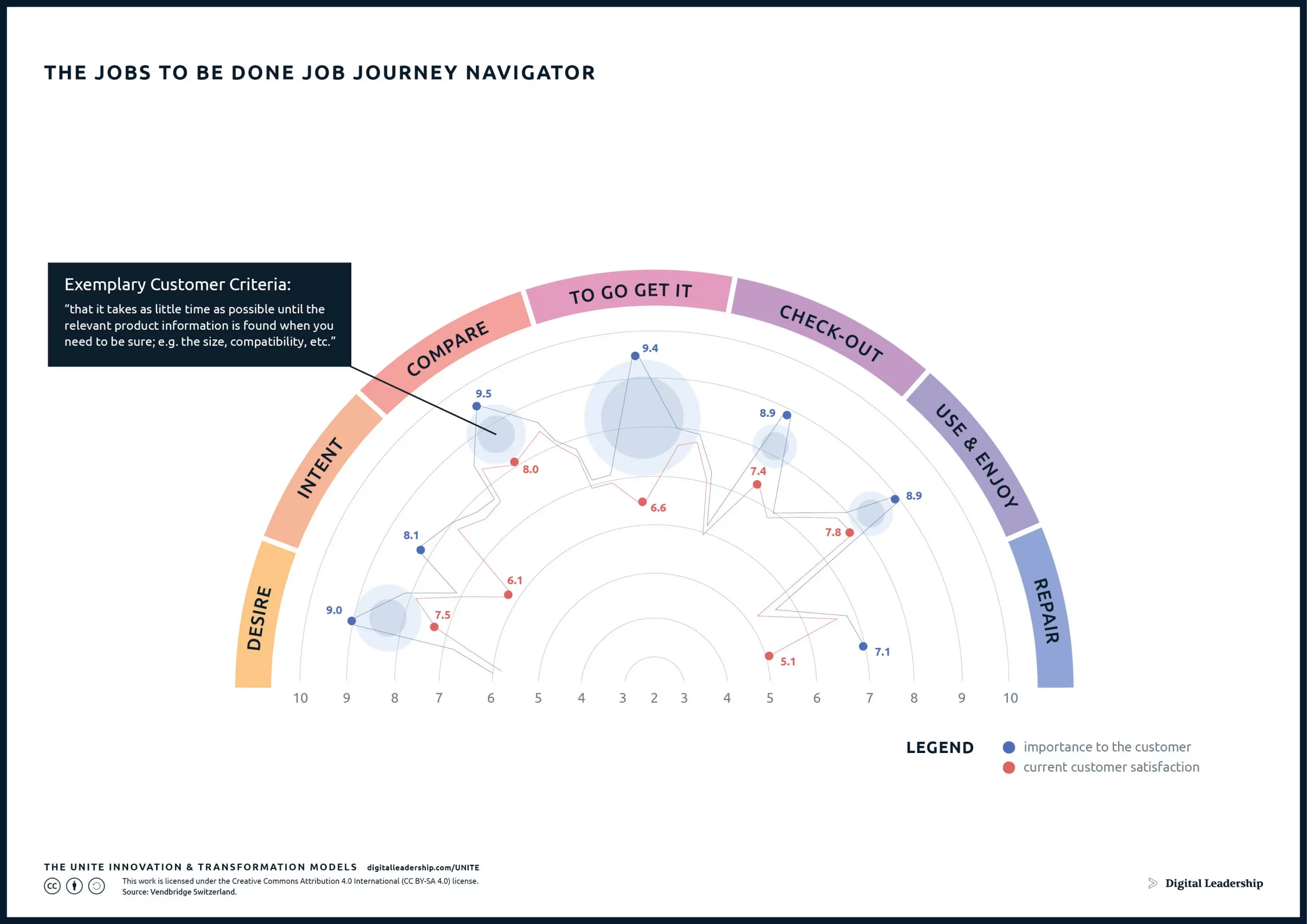Outcome Driven Innovation (ODI): Putting JTBD Theory into Action
Published: 24 June, 2023
Experience Design

Table of Contents
What is Outcome Driven Innovation?
Customer needs play a decisive role in product development and are the starting point for many innovations. Based on certain identified customer needs, the developers create new products or service offerings to satisfy these needs.
With traditional methods, a customer-centric strategy usually meant getting to know and characterizing one’s own customers as well as possible in order to be able to draw conclusions about their (consumer) behavior and needs.
American Harvard professor Clayton Christensen has developed a concept that claims that customers do not only select a certain product on the basis of needs but “hire” it in order to fulfill a job such as solving a problem.
In short: the focus is not on the product itself, but on its function and purpose.
This concept is called a job to be done, with the concept of outcome-driven innovation (ODI) based on it. Outcome-driven innovation was developed by the American innovation consultant Anthony Ulwick.
Outcome-Driven Innovation is crucial for businesses as it enables customer-centricity, differentiation, efficient resource allocation, and growth. At Digital Leadership, we offer an Innovation Consulting service focused on Outcome-Driven Innovation to help businesses seize emerging technology opportunities. By utilizing the Job To Be Done (JTBD) theory and the UNITE JTBD Universal Job Map, we gain a deep understanding of customer experiences and break down the product management process into smaller steps.
In the following article, Digital Leadership will present and examine these two methods in more detail and how they are beneficial for a company’s strategy and innovation process.
Related: https://digitalleadership.com/unite-articles/extended-business-model-canvas/
Outcome-Driven Innovation & Job To Be Done Theory
The Job to be Done Theory focuses on a deep understanding of the customer experience.
In order to understand how to improve an existing product or develop a new one, it is essential to first define the job customers want to fulfil.
The Job To Be Done Theory is based on the following three assumptions:
- Customers buy a product or service to perform a specific task
- The task is at the heart of the strategy and innovation process
- The jobs of customers open up completely new perspectives for you
According to Christensen, product analysis can be divided into functional and emotional aspects. The functional aspect refers to the practical factors of the job. The emotional aspect refers to how people perceive someone as a result of performing the job.
A Job to be Done can be framed in two steps:
- A one-sentence Job Statement that helps you articulate the customer’s needs in a given situation using their voice.
- The eight steps of the Job Map help you discover the smaller tasks and activities customers are doing to accomplish their jobs.

For a deep understanding of the Jobs to Be Done Theory visit our Article: https://digitalleadership.com/blog/jobs-to-be-done/
The Customer Value Job Statement
The customer’s job statement uses a simple sentence structure using the customer’s own words, describing the outcome he is ultimately hoping to achieve or the struggle he wants to overcome.
We recommend the following sentence structure for clarity:
- The customer’s voice: The statement is to be written from the customer’s perspective using their words and way of seeing the world. Start the statement with how they would identify themselves in this context. This is great for analyzing how customers measure value.
- The direction of improvement: What is the type of improvement the customer wants? What is the customer value that could be improved?
- What is being improved: For example, health, taste, efficiency, or safety. Feel free to evaluate the competing product in this section. How can you create breakthrough products?
- What or who is being affected by the improvement? For example, ordering produce, planning financial health, finding the right wine, or securing the health and safety of your family,
- Contextual clarifier: What describes the specific situation the customer is in? Use customer-defined metrics if needed.
Related: Massive Transformative Purpose (MTP) – Finding Your Business Purpose
With the customer Job Statement in place, we have successfully brought the customer into the project and achieved alignment in the team about where to focus our efforts. We are ready to move to the next phase:
Discovering what the customer does when trying to complete their job.
The UNITE JTBD Universal Job Map – Basis for Innovation Process

Designed by: Digital Leadership AG – Source: Lance A. Bettencourt and Anthony W. Ulwick.
The 8 Steps in Job Map:
With the help of a job map, the product management process of new or existing products can be broken down further into smaller intermediate steps. A job map usually consists of eight steps:
- Define and plan: Customers consciously or subconsciously create an initial plan for their approach to achieving their goal.
- Locate the input needed: Enable customers to identify and locate the information necessary for them to decide what to do.
- Prepare: Customers organize and make sense of the information, filter and qualify it, establish theories, and find more information or choose to make a decision about what to do.
- Confirm and validate: Customers make a decision to take action and validate it.
- Execute: Customers perform the action or procedure leading from the decision.
- Monitor: As the decision is executed customers monitor the effects and outcome.
- Modify: Monitoring creates new information which leads customers to assess their original decision. Did they make a good decision, or do they need to go back and make a new decision based on their new data? Do they just conclude (move to the next phase), or do they continuously monitor and improve their decision?
- Conclude: In some jobs, customers conclude at some point that their journey is over. They take stock of their situation based on their assessment from the modification phase and conclude if they were happy or not and learn from it.
Some things for product managers to keep in mind during this outcome-driven innovation process:
- These steps aren’t necessarily sequential or linear. There might be loops, sending customers back and forth between the steps. Some of the steps might happen at the same time.
- Some steps might be intuitive and take seconds to complete, while for others the same step might take weeks or months in order to create customer desired outcomes.
- Different customers will also try to solve jobs differently. Don’t try to find one optimal way of solving the job at this stage in your process; try to map out every possible way your customers are currently trying to solve it.
Result Oriented Innovations
The division of the core job into further steps gives a product manager a clear overview of the sub-aspects and, based on this, makes it easier to determine where exactly customers struggle and where improvement is needed in order to create breakthrough products.
This is where result-oriented innovation comes in.
Based on the problems in the job execution, desired outcome statements are identified in order to locate optimization methods.
These desired outcome statements consist of an improvement direction, a measure, an object, and a context addition and are a great help in measuring the success of outcome-driven innovation and breakthrough products.
The formulated statements are then used to conduct face-to-face customer interviews to determine if the statements align with customer value, as well as whether a customer’s satisfaction is in line with current market offerings.
The assessment is made on a scale from 1 (not at all important, not at all satisfied) to 10 (very important, very satisfied).
With the help of the opportunity algorithm developed by Ulwick, the statements are then prioritized and a clear picture of a possible saturated or unsaturated market situation emerges.
This can be exemplified through the UNITE jobs to be done Journey Navigator
The UNITE JTBD Journey Navigator

Source: Vendbridge Switzerland
The Job Journey Navigator by Venbridge Switzerland allows you to visualize the most important metrics for a job relative to how important they are to customers and how satisfied the customers are with current solutions.
Models like this can help a company identify opportunities for an effective product innovation process and accurately determine customers’ unmet needs.
An undersaturation of a customer’s need means there is an opportunity landscape for new product development or the further development of an existing product.
Conclusion
Job to be done and outcome-driven innovation are still new theories but hold great potential for a company’s innovation process and product strategy and reinventing ways customers are analyzed.
Using outcome-driven innovation can help discover hidden opportunities within existing and new markets through researching higher-level tasks (jobs) a customer wants to accomplish thus making innovation measurable.
Instead of general mission statements, the entire company with all its processes is aligned with the customer in a way that is highly relevant, creating customer value and changing the way customers are defined.
Ultimately, customers desired outcomes should be the foundation of innovation processes as it helps systematically create customer value and builds a wholly different relationship between the brand and the consumer.
Customer-defined metrics are tied in with an innovative research process that leads product managers to a new perspective on product, user, and competition.
































 Book How to Create Innovation
Book How to Create Innovation